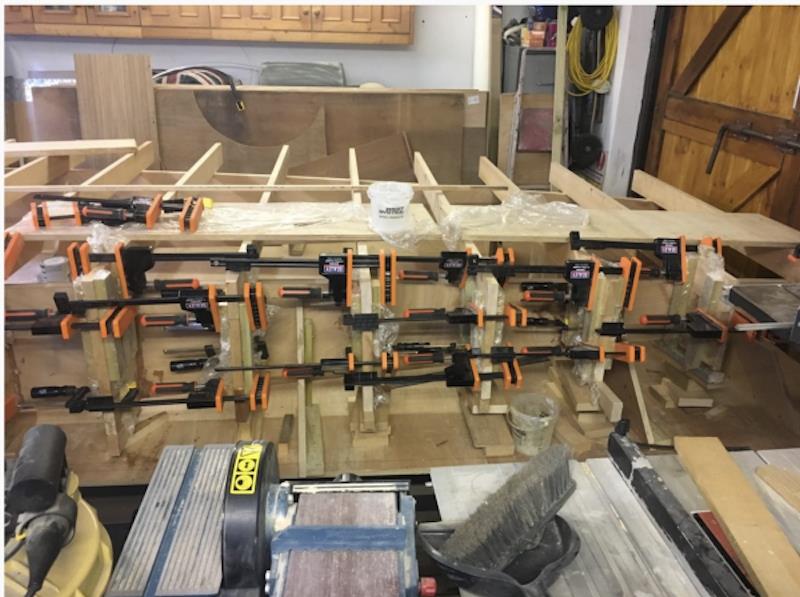
The Longbow Jet Hydroplane project benefits from Wessex Resins & Adhesives
by Jake Kavanagh 14 Feb 2019 06:00 PST

No shortage of clamps, although the team did admit that they had accidentally stuck one or two to the boat itself rather than to the plastic protectors © Wessex Resins & Adhesives
A team of British enthusiasts is building a jet-powered boat to beat the current water speed record of 317mph. WEST SYSTEM® Epoxy will be holding it all together.
Tucked away in a home workshop on the Fylde Coast, Lancashire, a remarkable hydroplane is taking shape. Powered by twin Rolls Royce Viper 535 pure thrust jet engines from the British Strikemaster aircraft, it will have a combined static thrust of 6800 lbs. This is double that of the current record holder, Spirit of Australia, in which Ken Warby set the record as the fastest boat in the world. The target the British team has to beat is an average speed of 317mph, but they think they have the design that will bring the record home.
Measuring nine metres (29.5ft) long, the new boat is named Longbow and will be made entirely of epoxy-impregnated wood. The epoxy being used is WEST SYSTEM 105 Epoxy Resin with 205 Fast Hardener, initially provided in a 30kg C pack. Both David Johnson and Hamish Cook of West System International have been assisting the project with sponsored product and technical advice.
They will be adding to a big reservoir of skill sets. This group of enthusiasts assisted with the recovery and restoration of Donald Campbell's iconic jet hydroplane Bluebird K7 that achieved seven Outright World Water Speed Records. The same group also went on to assist with the construction of a full-size replica of the craft complete with matching (and working) jet engine, so they are very familiar with jet hydroplanes.
Why wood?
With so many advances in composite materials, why is this project being built in wood?
Project co-ordinator David Aldred, a professional surveyor of wooden buildings, told Epoxycraft that it is probably the best material for the job.
"We could of course use materials like carbon fibre composite or, as in the case of Bluebird K7, all metal," he says. "However, supporting the case for wood is that the two previous holders of the record have both been made this way, including the penultimate holder, Hustler, which achieved 285mph. These boats won't have to cope with mountainous seas or wash from other competitors. Instead, they are travelling across smooth water which they are barely kissing as they plane over the surface."
David also points out that to make a carbon hull, they would first need a mould and to make a mould, they would need a 'plug', which will be a wooden version of the finished boat. So why not bypass the carbon stage completely?
"The hull and riding surfaces are all formed as one continuous piece," he says. "This means it is very difficult (and expensive) to make significant changes to a moulded carbon hull if proving trials made this necessary. By comparison, a timber hull is very easy to modify and be made equally strong again afterwards. Another consideration is the effects from any damage and water absorption during use. In composite hulls this is not very easy to detect. Also, hardware is difficult to retrofit should changes be required. On timber hulls, this is much easier."
Metal hulls also have their drawbacks. "They tend to be inherently heavy," David explains. "As in the case of Bluebird K7, they typically require high angles of attack to get all that weight onto their planing shoes. Aerodynamically, these high angles at the front become increasingly undesirable the faster the boat travels and we obviously want to reduce the risk of the craft lifting off and blowing over. Also, metal hulls can be susceptible to problems with heat-affected zones from welding, surface corrosion both inside and out and stress failures around rivets."
The timber being used is marine grade plywood and spruce, supplied by Bristol-based Robbins Timber. This long-served company is an approved WEST SYSTEM distributor so is well acquainted with the best materials for use with epoxy. Robbins is also a major sponsor of the project so is providing the team with all of their timber needs as the build progresses.
"As a surveyor specialising in wood I know that it is nature's own composite material, with certain species having terrific strength to weight ratio," David says. "This fact was ably demonstrated by one of the fastest and most loved aircraft of the Second World War, the Mosquito. With a recorded speed of 428mph, the airframe was constructed from plywood, balsa and spruce. In our case the marriage of engineered wood with formulated resins yields a hull that is lighter, stronger and more durable than a traditionally-built boat. Cold-moulded construction requires the least in highly technical and expensive construction. This allows our limited finances to be better spent on other aspects of the build."
By way of a closing comment, David remarks: "Just remember the strongest case of all for us choosing a timber hull was Noah's Ark, built in wood by amateurs. The Titanic, on the other hand,was built in metal by engineers!"
Epoxycraft will be bringing you regular updates focussed on the use of resins in the project and in the meantime you can follow the progress of the rest of the build, including harnessing those two jet engines at: www.jet-hydroplane.uk
See more stories and tips at epoxycraft.com/category/blog